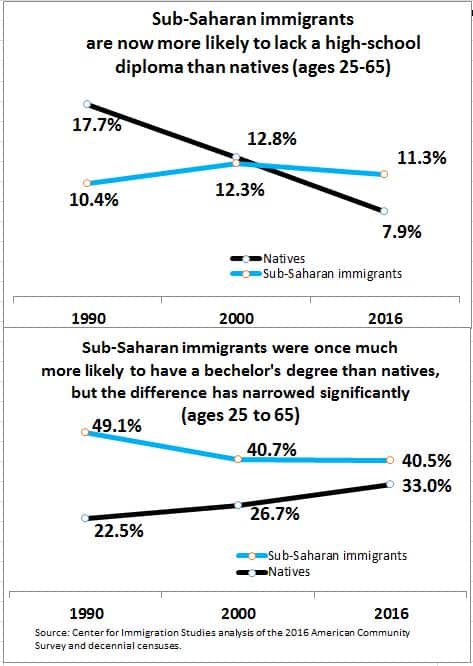The Truth About Immigrants from Sub-Saharan Africa
Steven Camarota, National Review, January 29, 2018
As a group, they’re highly educated. But as immigration from the region has increased, the education level of the new arrivals has declined. {snip} Overall, immigrants from [Africa] are relatively well-educated, and most can be described as at least middle class.
However, this population was much more educated decades ago. Back then they often came as students or to fill high-skill jobs. This produced a population that was small and much more educated than the native-born. But as the visa lottery, refugee resettlement, and family-based chain migration began to dominate the flow of new arrivals, the education level of this population declined relative to the native-born. As a result, a significant share of immigrants from this part of the world now struggle in the United States.
To be sure, sub-Saharan Africans are still more likely to have a bachelor’s degree than the native-born. But one of the consequences of chain migration and other categories that allow immigrants to enter without regard to their skills is that immigrants from this part of the world are no longer dramatically more educated than natives. {snip}
The overall growth in this population has been nothing short of extraordinary. Since 2000 it has increased 2.5-fold, to 1.8 million. It has grown almost 14-fold since 1980, a time period during which the overall foreign-born population has “only” tripled.
As the African-immigrant population has grown, its education levels have declined somewhat in absolute terms — and substantially relative to the native-born. In 1990, immigrants from sub-Saharan Africa were more likely than the native-born to have completed high school, and they were more than twice as likely to have at least a bachelor’s degree. By 2016, African immigrants were less likely to have completed high school, and while they were still more likely to have a college degree, their advantage over natives had shrunk dramatically: The share of sub-Saharan Africans age 25–65 with at least a bachelor’s degree had fallen from 49 percent from 41 percent, while for natives the same number had risen from 23 percent to 33 percent. (Sub-Saharan Africans are still much more educated than the average immigrant, of whom 27 percent have not completed high school and 31 percent have at least a college degree.)
There are also significant differences across countries. Of immigrants from Nigeria, 62 percent have at least a bachelor’s degree, compared with 11 percent from Somalia. {snip}
{snip}
The share of Africans above 200 percent of the poverty line — about $38,000 for a family of three in 2017, a reasonable cutoff for the middle class — is 58 percent, versus 72 percent for the native-born. This shows that while education levels are a good predictor of prosperity, they are no guarantee of it.
{snip} One reason such an educated group has such high welfare use is that refugees have immediate access to all welfare programs, and in recent years Africa has been one of the top refugee-sending regions.
These high poverty and welfare-use rates are not caused by low rates of work, however. African immigrants have one of the highest rates of work of any group in America and are more likely to have a job than immigrants generally or the native-born. Although most work, many still cannot support themselves or their children and turn to taxpayers and the welfare system. African immigrants help demonstrate how welfare and work often go together in today’s America, for immigrants and natives alike.
{snip}
{snip} It seems likely that if chain migration, the lottery, and refugee resettlement continue to dominate sub-Saharan African immigration, the education level of immigrants from this part of the world will continue to decline relative to those of the native-born. {snip}
















